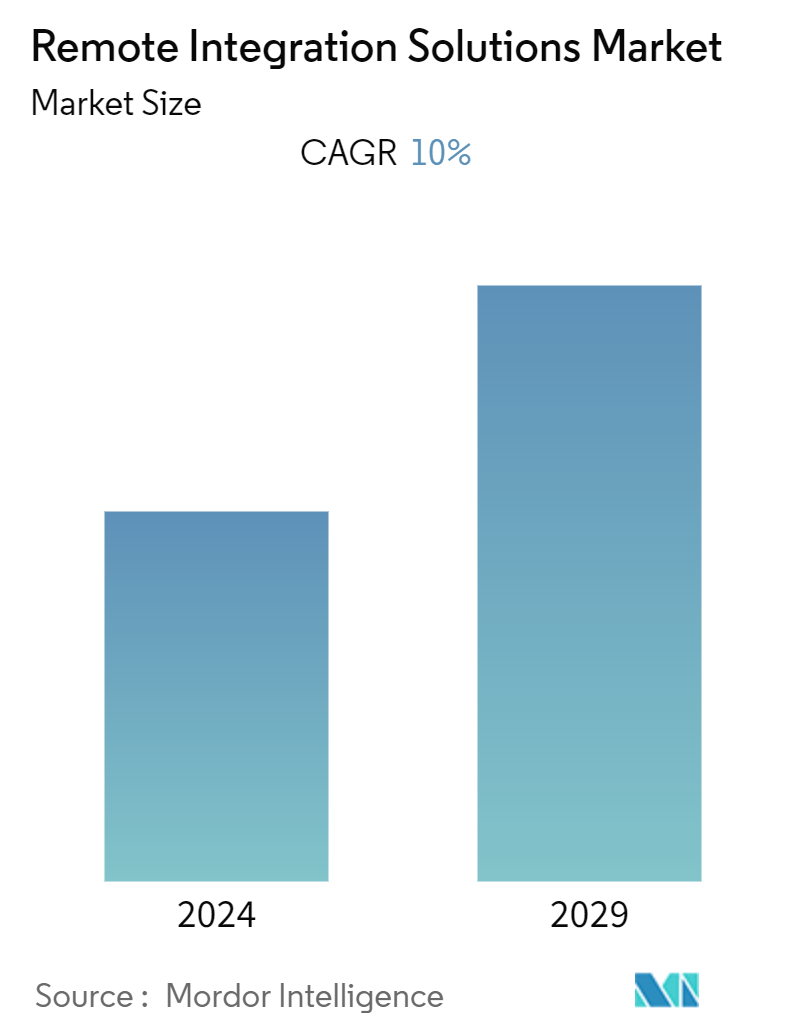Market Size of Remote Integration Solutions Industry

| Study Period | 2022 - 2029 |
| Base Year For Estimation | 2023 |
| CAGR (2024 - 2029) | 10.00 % |
| Fastest Growing Market | Asia Pacific |
| Largest Market | North America |
| Market Concentration | Low |
Major Players
*Disclaimer: Major Players sorted in no particular order |
Remote Integration Solutions Market Analysis
The Remote Integration Solutions Market is expected to register a CAGR of 10% during the forecast period.
The need to transform, analyze, monitor, and interpret all this data has become a preference to facilitate business processes as there is an exponential increase in the volume of data across enterprises. Additionally, due to the introduction of additional software, there is increasing complexity within the IT infrastructure.
- Hence, companies are incorporating enterprise application integration (EAI) systems to establish a cost-effective solution to change heterogeneous applications into a normal, recognizable platform to prevent this sophistication. Thus, companies combine media to link numerous enterprise systems with the web and wireless applications to facilitate the process. Hence, such characteristics are expected to drive the growth of remote integration solutions during the forecast period.
- There is a growing adoption of remote integration solutions for analytics and big data services as it helps to incorporate distributed IT systems with back-end techniques to examine the data in a centralized IT environment. Further, it helps interpret large volumes of data generated by companies, thereby delivering them with business insights.
- One of the critical issues in executing large-scale IT projects for remote integration solutions is experiencing technical faults and holds during integration. The primary reason for these technical faults and uncertainties is the intricacies involved in the scale of the organizational structure in large enterprises.
- Consequently, these technical glitches impede the efficiency of system implementation within large organizations, subsequently impacting their overall business performance. The measurement of key performance indicators (KPIs) has assumed paramount importance, making any delays a significant impediment to smooth business operations. Therefore, these factors are expected to pose challenges to the growth of remote integration solutions throughout the forecast period.
Remote Integration Solutions Industry Segmentation
A modern form of video broadcasting is Remote Integration (REMI), in which only small capture assets, such as Cameras and Microphones, are installed in the field. The principle behind REMI is to control costly capital in the area to minimize production costs. On-demand online streaming and broadcasting content providers develop an intensive market for conventional broadcasters. Conventional networks are looking to cover community sports and live activities to counter this and to have more options and personalized content for audiences.
The remote integration market is segmented by application (sports, broadcast, government, and healthcare), by type (large enterprise and SME), by products (transmitters, switches, decoders, accessories, and receivers), by geography (North America, Europe, Asia-Pacific, Latin America, Africa & Middle East).
The market sizes and forecasts are provided in terms of value USD for all the above segments.
| By Application | |
| Sports | |
| Broadcast | |
| Government | |
| Healthcare |
| By Type | |
| Large Enterprise | |
| SME |
| By Products | |
| Transmitters | |
| Switches | |
| Decoders | |
| Accessories | |
| Receivers |
| By Geography*** | |
| North America | |
| Europe | |
| Asia | |
| Latin America | |
| Middle East and Africa |
Remote Integration Solutions Market Size Summary
The Remote Integration Solutions Market is poised for significant growth, driven by the increasing need for businesses to manage and analyze vast volumes of data generated across enterprises. As organizations face the challenge of integrating disparate IT systems, the adoption of enterprise application integration (EAI) systems has become essential. These systems help streamline complex IT infrastructures by converting heterogeneous applications into a cohesive platform, thereby enhancing operational efficiency. The growing demand for analytics and big data services further propels the market, as remote integration solutions enable centralized data examination and interpretation, providing valuable business insights. However, the implementation of large-scale IT projects often encounters technical challenges, which can impede system efficiency and impact overall business performance. Despite these challenges, the market is expected to continue its upward trajectory, supported by advancements in service-oriented architecture (SOA) and industry service bus (ESB) technologies.
In North America, the adoption of remote integration solutions is particularly robust, with industries such as manufacturing, IT, and healthcare leading the way. The region's high internet penetration and willingness to embrace cutting-edge technologies, including mobile, cloud, and artificial intelligence, contribute to the market's growth. Key players like IBM Corporation, Omega Design Corporation, and Studio Technologies Inc. dominate the market, leveraging strategic partnerships and continuous product innovation to maintain their competitive edge. Recent developments, such as Boomi's partnership with Sazae Japan and the Royal Flying Doctor Service's migration to Oracle cloud infrastructure, highlight the growing importance of cloud computing in facilitating seamless system integration. These initiatives underscore the market's potential for expansion, as organizations increasingly seek to enhance operational efficiency and reduce costs through advanced integration solutions.
Remote Integration Solutions Market Size - Table of Contents
-
1. MARKET INSIGHTS
-
1.1 Market Overview
-
1.2 Industry Attractiveness - Porter's Five Forces Analysis
-
1.2.1 Bargaining Power of Buyers
-
1.2.2 Bargaining Power of Suppliers
-
1.2.3 Threat of New Entrants
-
1.2.4 Threat of Substitutes
-
1.2.5 Intensity of Competitive Rivalry
-
-
1.3 Industry Value Chain Analysis
-
1.4 Assessment of the Impact of COVID-19 on the Market
-
-
2. MARKET SEGMENTATION
-
2.1 By Application
-
2.1.1 Sports
-
2.1.2 Broadcast
-
2.1.3 Government
-
2.1.4 Healthcare
-
-
2.2 By Type
-
2.2.1 Large Enterprise
-
2.2.2 SME
-
-
2.3 By Products
-
2.3.1 Transmitters
-
2.3.2 Switches
-
2.3.3 Decoders
-
2.3.4 Accessories
-
2.3.5 Receivers
-
-
2.4 By Geography***
-
2.4.1 North America
-
2.4.2 Europe
-
2.4.3 Asia
-
2.4.4 Latin America
-
2.4.5 Middle East and Africa
-
-
Remote Integration Solutions Market Size FAQs
What is the current Remote Integration Solutions Market size?
The Remote Integration Solutions Market is projected to register a CAGR of 10% during the forecast period (2024-2029)
Who are the key players in Remote Integration Solutions Market?
Adeptia Inc., IBM Corporation, Pliant Technologies, Omega Design Corporation and Studio Technologies Inc. are the major companies operating in the Remote Integration Solutions Market.

